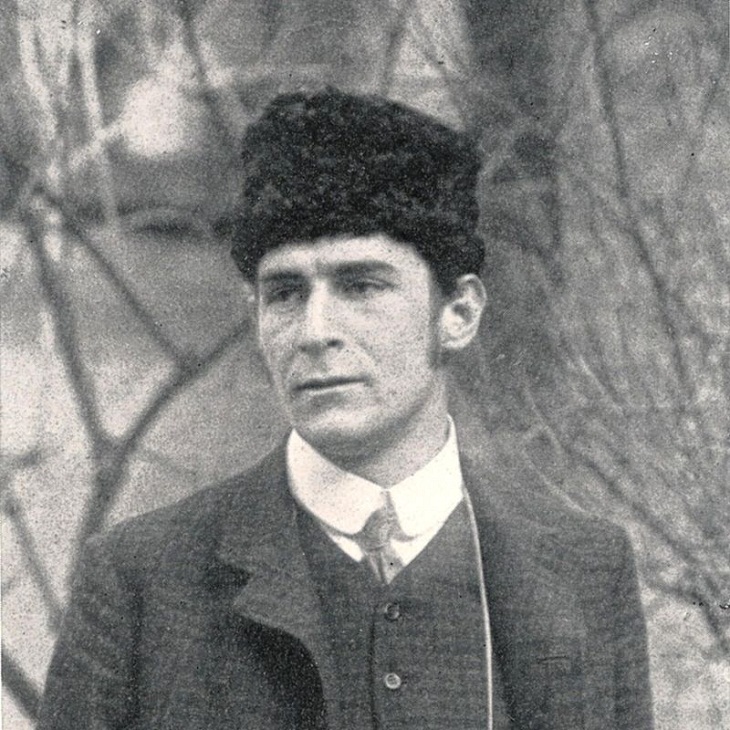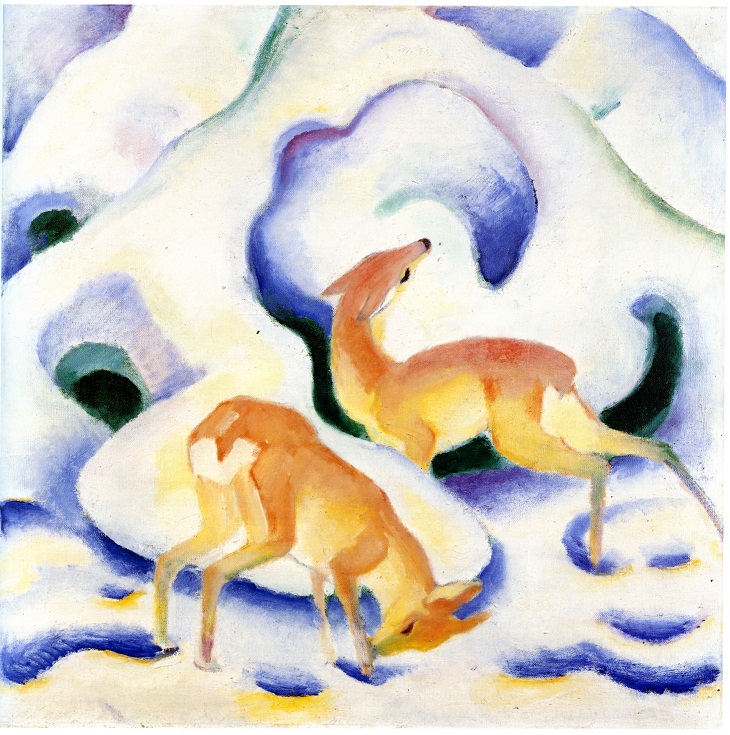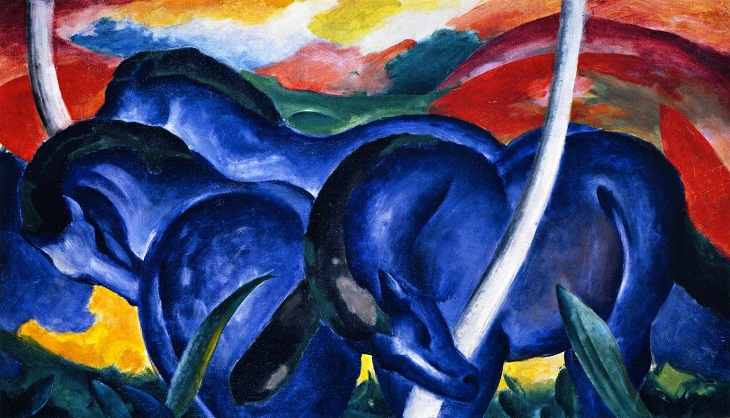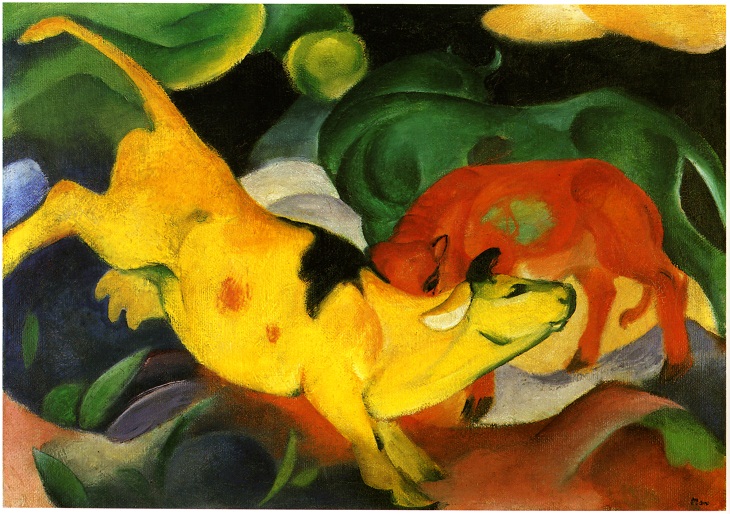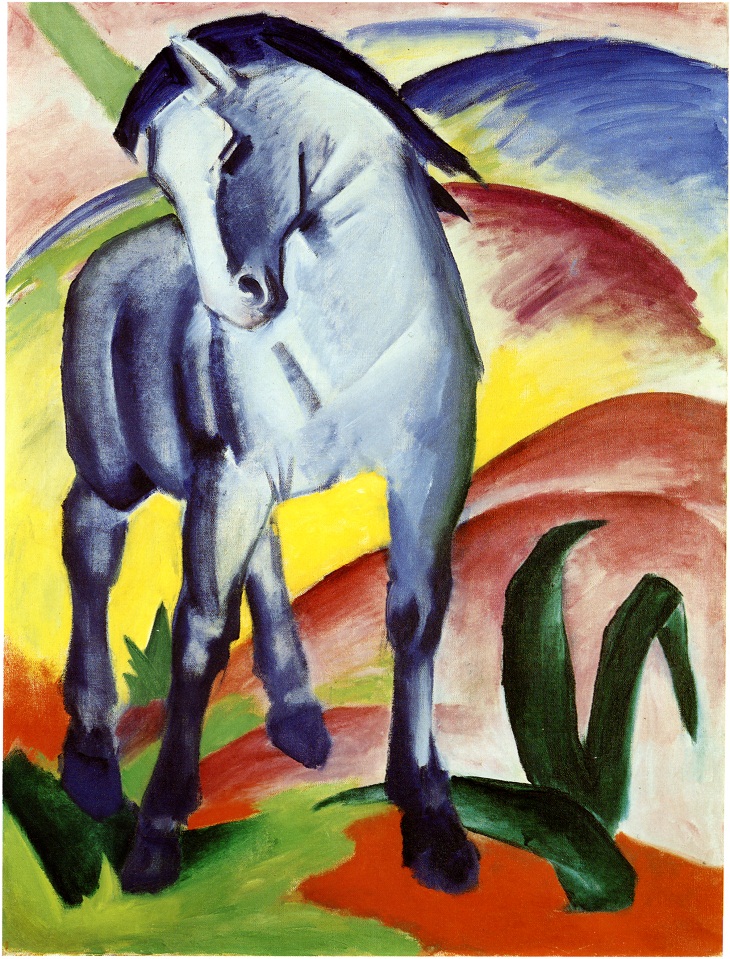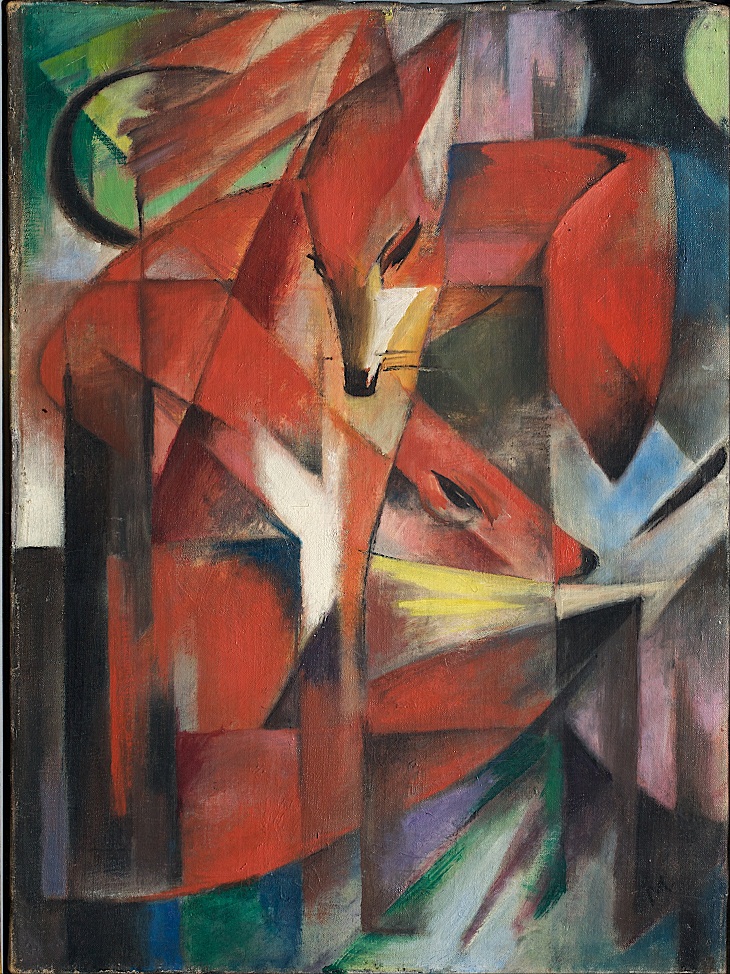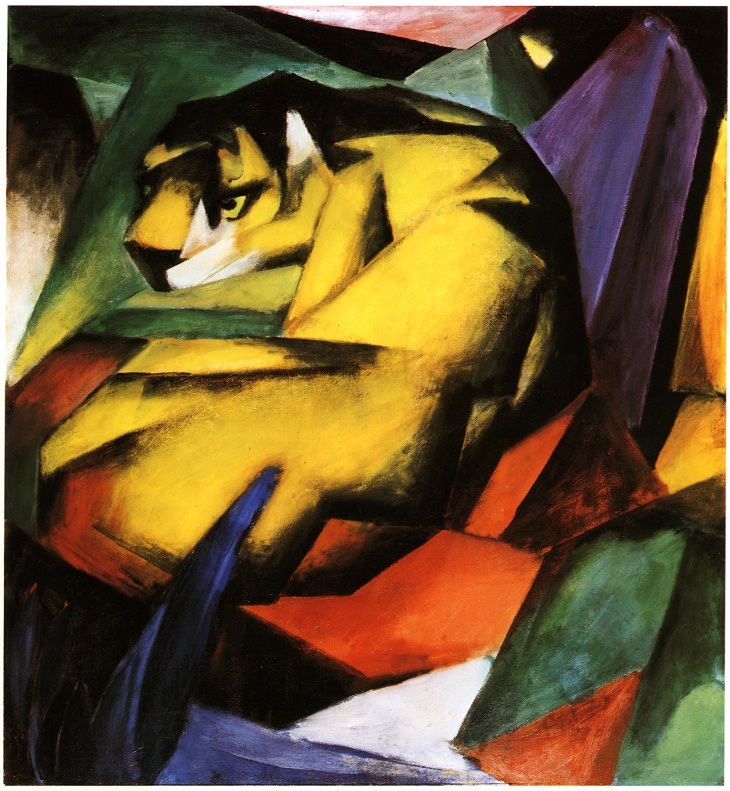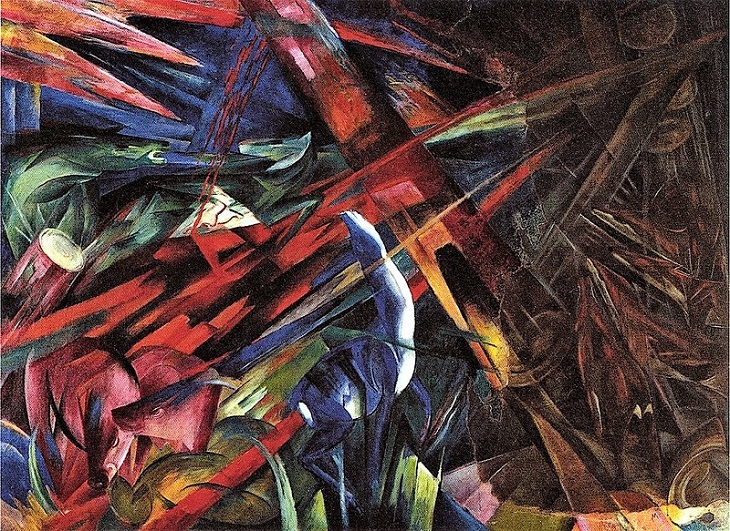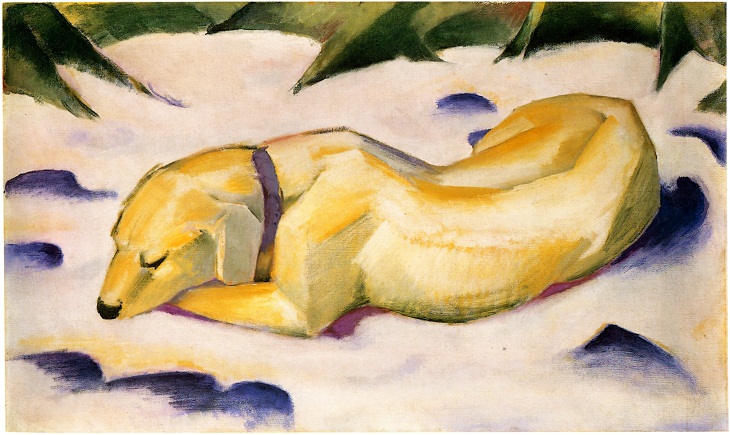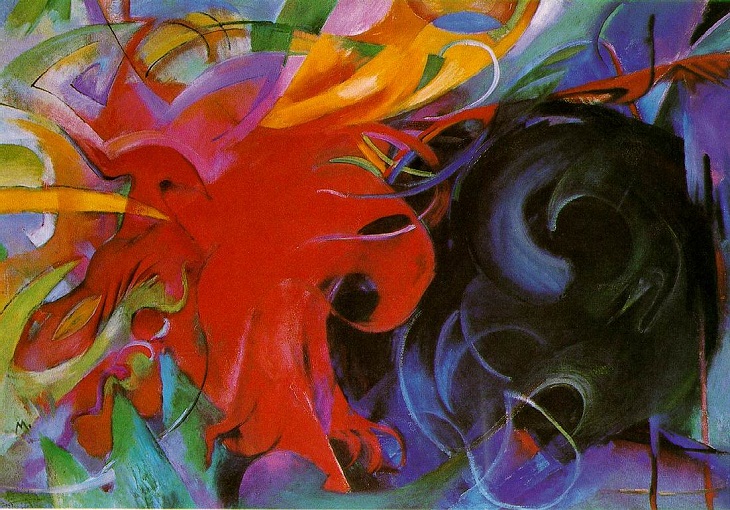Initially, the artist experimented with Naturalism and Realism but gradually became more attracted to abstract paintings. Marc chose animals as his subject matter. As a young boy, he often rode horses and loved all animals. He believed animals are purer than human beings and often depicted them as a spiritual medium in his paintings. According to the artist, this led him to the “inner truth.” Marc also used animal paintings to convey harmony between animals and their natural environment.
Franz Marc was so greatly influenced by the natural world that he perceived it as a remedy for modern life. For him, nature and animals were more than just pleasing to the eye; they had a profound spiritual meaning. The artist saw them as the pure and innocent manifestation of nature and energy.
In a 1915 letter to his wife, Marc expressed his disgust with modernity and human beings and his deep connection with animals. Marc wrote: “People with their lack of piety, especially men, never touched my true feelings. But animals with their virginal sense of life awakened all that is good in me.”
What techniques did Franz Marc use?
Interestingly, Marc’s animalization of art didn’t simply involve beautiful paintings of animals in spectacular landscapes. He would almost always intensify the colors and simplify the drawings of his subjects. Color was extremely important for Marc. His energetic use of primary and secondary colors is evident in most of his animal paintings. Marc associated blue with the masculine, yellow with the feminine, and red with the physical world in his artworks.
Marc once said: "Blue is the male principle, severe and spiritual. Yellow is the female principle, gentle, cheerful, and sensual. Red is matter, brutal and heavy, the color that has to come into conflict with and succumb to the other two. For instance, if you mix blue — so serious, so spiritual — with red, you intensify the red to the point of unbearable sadness, and the comfort of yellow, the color complementary to violet, becomes indispensable."
Marc’s lavish use of color symbolism in his art was inspired by Vincent van Gogh who used color to represent emotion. He expanded upon that technique by using vivid colors to humanize his animal forms.
Marc also studied animal anatomy to become more familiar with their form. However, he would paint his animal subjects without using a model. He saw the animals in his paintings in the context of iconography (a particular range or system of types of images used by an artist to convey particular meanings) instead of representation.
Animals and pantheism
Marc's own belief system was centered on pantheism, and his portrayal of animals was closely connected to his beliefs. Pantheism is the belief that God is in all things in the universe and nature, and Marc's works constantly present nature through the pure eyes of animal figures.
In a 1915 letter to his wife, Marc noted that his pantheism resulted from his revulsion from modernity and human beings. Animals, he said, “with their virginal sense of life awakened all that is good in me.” While other Expressionists of that time looked at the lives of peasants and primitive cultures for inspiration, Marc observed nature.
The formation of Der Blaue Reiter
1910 proved to be a turning point in Franz Marc’s life because he met August Macke, another German Expressionist. The two men developed a friendship based on their mutual interests in the arts. Around this time, Marc also formed a connection with the Russian artist Wassily Kandinsky. The three artists then went on to form the German Der Blaue Reiter group, meaning The Blue Rider, in 1911. Various sources state that the name could have been derived from Marc’s love for horses and the color blue combined with Kandinsky’s affinity for riders.
The main aim of Der Blaue Reiter was to allow artists the platform to express whatever they felt or believed. The group was also interested in depicting nature and the universe as a way of self-expression.
Today, Der Blaue Reiter is known as one of the main movements in German Expressionism.
The influence of Robert Delaunay on Franz Marc’s works
In 1912, Franz Marc met French artist Robert Delaunay and was instantly impressed with his lively Cubist style. Delaunay was the founder of the art movement called Orphism, which involved abstract and geometric shapes.
Under Delaunay's influence, Marc began experimenting with simultaneous color contrast, the condition wherein two surfaces with the same spectral composition are seen as having a different color when placed against different chromatic backgrounds. His painting Tiger (1912) is a good example of this.
The best animal artworks of Franz Marc
As mentioned above, animals played a key role in many of Franz Marc’s works. So, let’s take a look at some of the best animal paintings by the German artist.
1. The Yellow Cow (1911)
The Yellow Cow is one of Marc’s most well-known works. In this 1911 painting, we see a yellow cow jumping across a serene landscape. The animal appears to be at ease with itself. Marc painted this as a tribute to his second wife, Maria Franck. Over the years, the painting has been interpreted as purely joyous.
As you can see, the two most dominant colors in this painting are yellow and red. Marc described the color yellow as “the female principle, gentle, gay, and sensuous.” The landscape features dashes of red - the color that symbolized Earth to him. The blue spots represented the color of spirituality for the artist. The cow reflected the safety and security Marc felt in his second marriage.
2. Blue Horse 1 (1911)
Marc loved horses, and Blue Horse 1 was the first in a series of paintings he made about blue horses. The blue horse was recognized as the spiritual compass of the group Blaue Reiter.
Marc saw the color blue as “the masculine principle, astringent and spiritual.” The horse represents spirituality, strength, and vivacity. The yellow femininity in the background mixes perfectly with the horse’s masculinity leading to a bright green.
You can also see other primary colors in the background, which symbolize the various elements of emotional energy. The reds, in particular, blend with the masculine and feminine tones.
3. The Foxes (1913)
This 1913 artwork is said to be inspired by cubist paintings, including the works of Robert Delauney and other Cubist artists. Here, we see two foxes broken down into fragments and recomposed in rhythmical colors. While The Foxes is influenced by cubism, a very symmetrical art style, Marc has expressed his artistic style quite freely here.
As you can see, red is the most dominant color in this painting. According to Marc, red “is matter, brutal, heavy, and always the color that the other two, must oppose and overcome!” Art connoisseurs say that the “other two” is a reference for blue and yellow, which, as discussed above, represented masculine and feminine colors respectively for the artist. The red in this painting is evened up by the yellows, greens, and blues surrounding the animals.
4. Tiger (1912)
Painted in March 1912, this famous piece shows a tiger, composed predominantly of cubic forms, perched upon a rock. The animal is colored in gleaming tones of yellow and black. The dreamy worlds we saw in Blue Horse I or Yellow Cow are missing here. They are replaced with a sense of apprehension.
The tiger’s bodily strength is characterized by crisscrossing fragments of color and acute angles and is firmly enclosed within the bold, black outline. This is a very dynamic composition and depicts the tiger ready to break free to make an attack. In most of his other paintings, Marc shows animals in a state of harmony with their natural surroundings. But here, he has used cubist techniques to manifest a feeling of tension while retaining his approach to the color and subject matter.
5. Fate of the Animals (1913)
This intriguing masterpiece by Franz Marc features animals being violently slaughtered. It has a sense of apocalypse and doom, a reflection of the artist’s personal turmoil before the start of the First World War. Fate of the Animals is in deep contrast with his other paintings, where the animals usually appear calm and happy.
In his 1915 letter to his wife Maria, Marc explained that this change in his art happened because he began to see the unpleasant side of animals, which he had previously thought only existed in humans. He further expressed that he no longer found beauty in animals. Why he felt so is unknown. However, it’s widely speculated that in the apprehension of the First World War, Marc began seeing animals as part of the world of man, a world that was in dire need of sanctification.
Despite the chaos in the painting, the blue deer standing in the center foreground, swiveling its head away from the falling tree, symbolizes hope. It indicates that the artist had a hopeful vision of the future.
6. Dog Lying in the Snow (1911)
This painting is another example of Marc’s depiction of the sanctity of animals through his works. While he had studied animal anatomy, the artist wasn’t too concerned about being zoologically accurate; he wanted to capture the essence of animals in his paintings, as you can see here.
The painting is of Marc's own Siberian Shepherd dog, Russi, during winter near the village where he lived. The relaxed jowl over the supporting paw suggests the animal is at ease with itself.
The artist had said that the snowy landscape, while beautiful, was "too pure white and blue." He still managed to create this wonderful composition featuring yellow, blue, and green. While Marc made several intricate paintings, this one is adored for its simplicity of color and form, giving the viewer a feeling of peace, calmness, and harmony.
7. Fighting Forms (1914)
This was one of Marc's final works before the outbreak of the First World War. He created Fighting Forms as a representation of the turmoil he felt during the conflict. During this time, most of his works included non-representational forms and abstraction. This one revolved around two swirling shapes - one red and the other black. It means to show two opposing forces and was the consequence of a country at war.
When World War I broke out, Marc enlisted. For a short time, he was asked to camouflage artillery because of his painting skills. The artist began entertaining himself by making patterns inspired by Manet and Kandinsky.
Soon, however, there was an order to save artists from combat to protect German art. Several distinguished artists of the time were taken out of action. Unfortunately, Marc was killed in the battle of Verdun on March 4, 1916 - before the orders were carried out.
Share this post with other art lovers!

